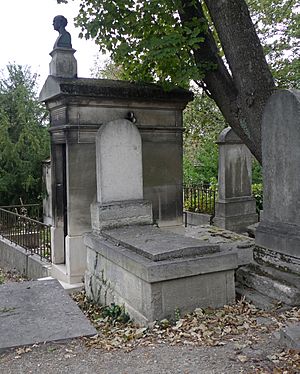Charles Messier facts for kids
Quick facts for kids
Charles Messier
|
|
|---|---|

Charles
|
|
| Born | 26 June 1730 Badonviller, France
|
| Died | 12 April 1817 (aged 86) Paris, France
|
| Known for | Messier catalog |
| Awards | Cross of the Legion of Honor |
| Scientific career | |
| Fields | Astronomy |
Charles Messier (born June 26, 1730 – died April 12, 1817) was a famous French astronomer. He created a special list of 110 fuzzy objects in space. These objects are called Messier objects. His goal was to help other astronomers tell the difference between comets and other space objects that looked similar. Comets move, but Messier objects stay in the same place.
Contents
Charles Messier's Life Story
Messier was born in Badonviller, a town in France. He was the tenth of twelve children. Sadly, many of his brothers and sisters died young. His father passed away in 1741.
Charles became interested in space when he saw a huge comet with six tails in 1744. He also saw a solar eclipse from his hometown in 1748. These events made him want to learn more about the sky.
Starting His Astronomy Career
In 1751, Messier started working for Joseph-Nicolas Delisle. Delisle was the astronomer for the French Navy. He taught Messier how to carefully record his observations of the sky.
Messier's first recorded observation was of the planet Mercury passing in front of the Sun. This happened on May 6, 1753. He kept detailed journals of his observations from different observatories.
Achievements and Nickname
Messier became a respected astronomer. In 1764, he was made a member of the Royal Society in England. In 1769, he joined the Royal Swedish Academy of Sciences. Then, in 1770, he became a member of the French Academy of Sciences.
King Louis XV gave him a special nickname: "Ferret of Comets." This was because Messier was very good at finding comets.
Comets Discovered by Messier
Messier discovered many comets during his career. Here are some of them:
- C/1760 B1 (Messier)
- C/1763 S1 (Messier)
- C/1764 A1 (Messier)
- C/1766 E1 (Messier)
- C/1769 P1 (Messier)
- D/1770 L1 (Lexell)
- C/1771 G1 (Messier)
- C/1773 T1 (Messier)
- C/1780 U2 (Messier)
- C/1788 W1 (Messier)
- C/1793 S2 (Messier)
- C/1798 G1 (Messier)
- C/1785 A1 (Messier-Méchain)
He also helped discover Comet C/1801 N1. Other astronomers like Pons and Méchain also found this comet.
Messier is buried in the Père Lachaise Cemetery in Paris. His grave is close to the famous composer Frédéric Chopin.
The Messier Catalogue

Charles Messier was a dedicated comet hunter. As he searched, he often saw fuzzy, fixed objects in the night sky. These objects could easily be confused with comets.
To avoid wasting time, he decided to make a list of these objects. He worked with his friend and assistant, Pierre Méchain. Méchain actually found at least 20 of the objects on the list!
What's in the Catalogue?
Today, we know the Messier Catalogue includes:
- 39 galaxies (huge groups of stars)
- 4 planetary nebulae (glowing clouds of gas and dust)
- 7 other types of nebulae (other kinds of gas and dust clouds)
- 55 star clusters (groups of stars held together by gravity)
Messier used a 100 mm (four-inch) refracting telescope for his observations. He worked from the Hôtel de Cluny in downtown Paris. This building is now the Musée national du Moyen Âge.
The catalogue only includes objects that Messier could see from his location. These were objects visible from the northern sky down to a certain point. The objects are not listed in any scientific order, like by type or location.
How the Catalogue Grew
The first version of Messier's catalogue came out in 1774. It had 45 objects. Only 17 of these were discovered by Messier himself. The rest had been seen by other astronomers before him. By 1780, the list had grown to 80 objects.
The final version of the catalogue was published in 1781. This list had 103 objects. Later, between 1921 and 1966, astronomers found evidence of seven more objects. These were observed by Messier or Méchain shortly after the final list came out. These seven objects, from M 104 to M 110, are now also considered "official" Messier objects.
Today, the Messier designations (like M 1 or M 110) are still used. Both professional and amateur astronomers use them. These objects are popular because they are relatively bright and easy to find.
Legacy
To honor Charles Messier, a crater on the Moon was named Messier. Also, an asteroid called 7359 Messier was named after him.
See also
 In Spanish: Charles Messier para niños
In Spanish: Charles Messier para niños
- Deep-sky object
- List of Messier objects
- Messier object
- Messier marathon
- Caldwell catalogue



